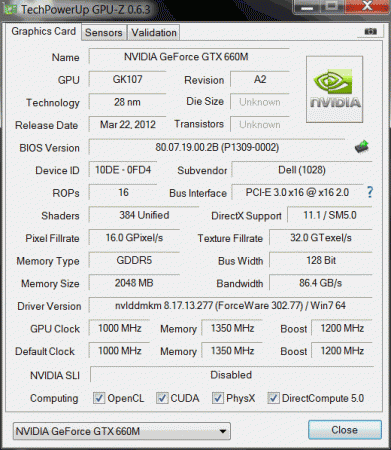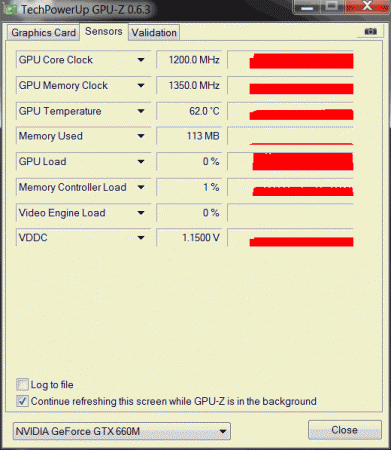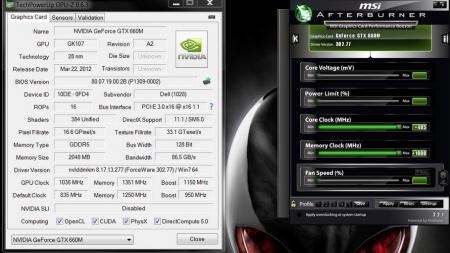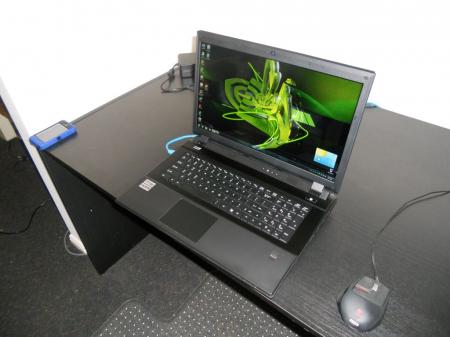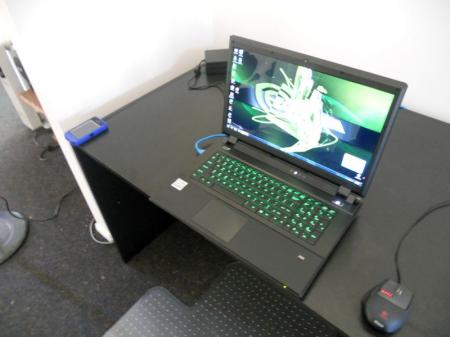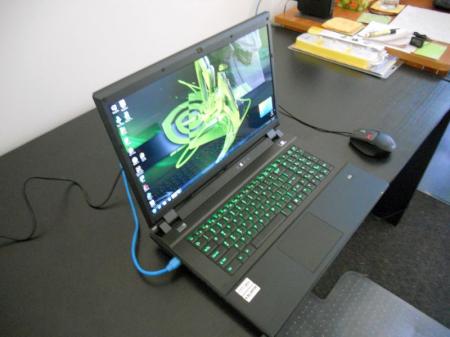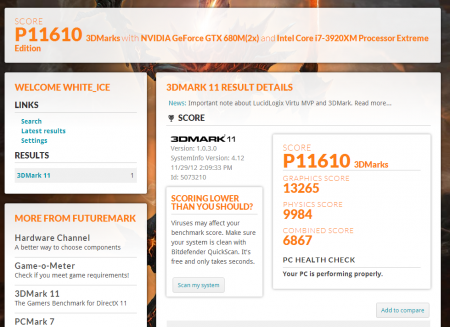Leaderboard
Popular Content
Showing content with the highest reputation on 12/01/12 in all areas
-
Just joined up here as the site looks to have some great info and examples of high end Laptop / notebooks and i recently sold up my extreme desktop and bought a crazy new Clevo machine (P370EM) as i will be travelling and still want massive grunt! This machine is amazing and i love it.. Just looked in the benchmark sections and cannot see the model P370EM ??? Am i blind or is it not there ? Already found some info here that was helpful so looking forward to becoming more active on here.. p.s Sorry i didn't put this in the right area as i didn't see the "introduce yourself section" my bad.. Thanks, Dave.3 points
-
Yeah he's gonna totally use this advice.... 1.5 year after he posted the question.2 points
-
UPDATE: ALL DOWNLOADS LISTED IN THIS POST FOUND HERE. Nvidia 'Kepler' GPUs - modified VBIOS files >>> NOTE: More versions (including voltage mods) exclusive for T|I users can be found in the second post. <<< The 'Kepler' GPUs from Nvidia perform really well, even at increased clocks speeds they stay quite cool - a perfect behavior when it comes to overclocking and improving the performance. Unfortunately the mobile GPUs suffer from an artificial +135MHz core overclocking limit, so you can't go higher by using tools like Nvidia Inspector and similar. The modified VBIOS files listed here have this limit unlocked, some have increased stock clocks or tweaked voltages. Just refer to the description. All files have been modified by myself, if you like them feel free to buy me a drink, donation link can be found below GTX 660m: 660m_OC_edition__VBIOS_[DELL].zip- comes with unlocked software overclocking limits 660m_GHz-Edition_overvolted_VBIOS_[DELL].zip - default 3d clock 1000MHz, base boost 1200MHz,, memory (3d) 1350MHz, increased 3d voltage undervolted editions possible, depends on interest, tba Some screenshots: GTX 680m: Clevo_680m_-_80.04.33.00.10_'OCedition'_revised_01.zip Dell_680m_-_80.04.33.00.32_'OCedition'_revised_00.zip Increased software overclocking limits & optimized for no throttling. Read the included 'Read me' file before flashing. Instructions: I recommend flashing under DOS using nvflash . Donation link in case you want to buy me a beer Thanks and cheers! More to come. Testers: Thanks @eliteone (Dell 660m), @littleone562 (Dell 680m) For all mods: Use at your own risk.1 point
-
So you've got hold of a 4GB version of a GTX 680m, figured out how to flash the vbios and it runs well. However, there are some things missing such as GPU boost and the ability to actually install drivers easily. Perhaps you are reluctant to run a vbios that ups to voltage to 1.037v. This thread aims to have everyone owning a 4GB GTX 680m get the most out of their GPU including enabling a GPU boost hack. This is not an overkill thread, but more about getting things working well with a good performance, quality and stability improvement over stock. There will be no crazy high voltages so everything should be safe short and long term however I take no responsibility for burnt or bricked cards. Please proceed at your own risk, there will be vbios flashing. First of all, the GTX 680m is similar to the desktop GTX 670 but severely downclocked. By OC'ing, one can get the core speed up to speed and beyond but clocking the memory @3Ghz (6GHz effective) in an attempt to reach its 192GBit/s bandwidth is very risky and likely dangerous. However, if the memory is clocked to 2250 (4.5Ghz effective) then the bandwidth is identical to that of the GTX 660 Ti @144GBit/s. Both desktop GPUs have the same base and boost clock at 915Mhz and 980Mhz respectively. This brings me to the vbios. Kindly created by master hex maestro svl7. The vbios (attached below) clocks in @915/1125(2250)Mhz exactly the same as that which I mentioned above. Those specific clocks are also what makes the GPU boost work well (I'll get to that later). The vbios is engineered from the MSI ES(FD) vbios and has a voltage of 1.025v and settles @1.0v during constant load. Not amazingly(potentially dangerously) high but there is still plenty of headroom for overclocking. Flash this, and verify with GPUz. Of course the memory clock can be anything but I chose 1125 as they are nice and neat as well as offering a mild but significant boost in performance. Next, drivers. The recent nvidia drivers are great but digging deep into the source code, we find that there are image quality hacks that trade image quality for performance. Plus some drivers just plain won't install if the GTX 680m is an aftermarket upgrade on unsupported mobos. These drivers are winners though: http://files.laptopvideo2go.com/Dox/geforce306.02.2-modded.exe Modded by the infamous Dox, all hacks are removed, quality is optimsed and support for all nvidia devices is included and should install without a hitch on any system. Drivers are uber stable but not great benchers as image quality is improved at some cost to performance. but I'd happily trade performance for decent quality and stability and use another driver to bench. And finally, enabling GPU boost. This method is not actually GPU boost but it functions in exactly the same way, call it "fake" GPU boost. What we need to do is to download Nvidia Inspector: NVIDIA Inspector 1.9.6.6 download from Guru3D.com Put that in a safe place and run it, allow overclocking and set the base offset to +65 to achieve 980Mhz, the same as the desktop cards. Now some of you may think that this is plain overclocking however, this is not the case. After applying the clocks (keep Inspector open), run a mild to moderately intensive GPU task such as playing HD video or opening the settings dialogue of Furmark (but not starting any test yet) and you will see that the clocks will still show 914.5Mhz. Start a game or Furmark and that will jump to 980Mhz similar to GPU Boost. Now click on "Create clocks shortcut" and a new shortcut should appear on the desktop. Drag that to your "Startup" folder in the Start menu and Fake GPU Boost should be enabled on every restart without any user input needed. I tested other base clock speeds ranging from 900Mhz up to 1000Mhz and and every boost clock speed from +1 to +100 and 915 -> 980 was the only combination that worked. Most other base clock speeds would always change to 928Mhz and without the 915Mhz baseclock, all other fake boost clock offsets would go to 966Mhz unless I went way beyond 1Ghz which I don't recommend anyway. Either it was coincidence that those clock speeds are identical to the desktop ones or that they are the only clocks that work on the GK104 which is why nvidia set them to the desktop ones in the first place. Please report back if you have any issues. I've only tested this myself but it should apply to all 4GB GTX 680m users. EDIT by svl7: Vbios is outdated, grab the latest one here: http://forum.techinferno.com/general-notebook-discussions/1847-nvidia-kepler-vbios-mods-overclocking-editions-modified-clocks-voltage-tweaks.html1 point
-
Hi members, just joined and found some awesome info for my new Clevo including bios mods etc.. So ill be sticking around here and thought id post up my new toy. Bought it to replace my extreme desktop i had as i will be travelling to Europe and can take this little monster with me and still have about the same performance. It blew me away when i benched it and it has so much more potential, with help from on here im sure a few of you will be able to help me get even more out of it, not that its needed but still fun.. lol Anyways, few pics and result i got without really pushing it. Sorry for the quality, my good camera died few days ago.. http://www.3dmark.com/3dm11/50732101 point
-
@Clevorr welcome to T|I Dave! I added your model to the clevo benchmarking section, let me know if everything is ok now.1 point
-
seem to work for PxxEM ... but i can confirm it still don't work on PXXHM ... same bug as previous.1 point
-
Don't use the Dell one for Clevo cards, this is the one you want: http://forum.techinferno.com/attachments/general-notebook-discussions/5461d1354034760-clevo-680m-80.04.33.00.10-ocedition-revised_01.zip The command should be the same as desktops: nvflash -4 -5 -6 -i0 <rom name="">rom <---Card 1 nvflash -4 -5 -6 -i1 <rom name="">.rom <---Card 2 Some people choose not to do -4 -5 but I do anyway.</rom></rom>1 point
-
Mainly only because of drivers. I have always run multiple GPU,s and in my old x7200 had dual 6990,s and it was a nightmare for me in terms of driver / game compatibility issues etc.. just lots of little bugs all the time so since then went to Nvidia and never had a problem since. neither is perfect but i can't stand driver issues. If AMD could sort that area out they would be hard to beat IMO..1 point
-
Even the Dell 7970m work perfect with HDMI out and the M18x R1 Paranoid Galaxy S3 on Tapatalk 21 point
-
1 point
-
Looks as things are coming nicely with the Dell cards as well Nice scores!1 point






